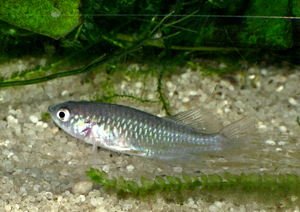Magnificent orchid parrot
| Magnificent orchid parrot | ||||||||||||
|---|---|---|---|---|---|---|---|---|---|---|---|---|

Prachtgrundkärpfling orchid ( Nothobranchius eggersi ) (male, blue color) |
||||||||||||
| Systematics | ||||||||||||
|
||||||||||||
| Scientific name | ||||||||||||
| Nothobranchius eggersi | ||||||||||||
| Seegers , 1982 |
The orchid prachtgrundkärpfling ( Nothobranchius eggersi ), also known as "Eggers prachtgrundkärpfling", is a toothcarp of the genus Nothobranchius . It is named after one of its discoverers, Gerd Eggers. The co-discoverer Lothar Seegers wrote the first description for this splendid ground carrot .
features
The males are 5 cm long, the females 4 cm long. The males are extremely colorful and therefore popular with specialized aquarists despite their very short lifespan. The color of this species is very variable. In the case of the blue color form, the males have a light blue basic color that turns greenish to the back and then brownish. Numerous scales are patterned in dark red, so that either a net-like or V-shaped pattern results. There are red spots of color in the unpaired fins and often also in the ventral ones. The edges of the dorsals and anal are broadly lined with white and cream color. In the "red head" color variant, the head is intensely red. In the "red" color variant, the head is intensely red, the red pattern on the body is somewhat stronger and the entire caudal fin and the outer areas of the anal and dorsal fin are dark red. There is also a "solid blue" cultivated form with very few red-colored scales. The females are monochrome light brown - silvery.
distribution and habitat
The species lives in East Tanzania in Africa in the area of the Ruhoi River. The home waters are usually unshaded, with a soft, muddy bottom. The fish are kept in pools and gullies that are sometimes exposed to water, so they are seasonal fish .
Reproduction and aquaristics
The male impresses in front of the female and swims around it. If this is ready to mate, it follows to a spawning site. To spawn, the female hugs the male and both dig a few centimeters into the ground, where spawning takes place. In the wild, the habitat of Nothobranchius eggersi dries up . The eggs remain moist in the soil, where the young fish develop. They hatch during the next rainy season.
In the aquarium, the fish are spawned in a layer of peat at least 5 cm thick (made of unfertilized fiber peat). The peat is dried to residual moisture and then stored in a plastic bag for 2 months. It is important that the peat base does not become moldy or moldy. After 2 months, the peat is placed in the rearing tank, where the fry hatch after a few hours.
Hints
- ↑ Profile of the German Killifisch Gemeinschaft ( Memento of the original from May 16, 2008 in the Internet Archive ) Info: The archive link was inserted automatically and has not yet been checked. Please check the original and archive link according to the instructions and then remove this notice.
- ^ Gerhard Schreiber, Jürgen Schmidt: Killifische , p. 91, bede-Verlag GmbH, Ruhmannsfelden 2000, ISBN 3-931792-88-9
- ^ Ines Scheurmann: Züchten aquarium fish , p. 104f, Gräfe and Unzer GmbH, Munich 1989, ISBN 3-7742-5063-4
Web links
- Orchid-Prachtgrundkärpfling on Fishbase.org (English)
- Nothobranchius eggersi on killi-fisch.de
- Nothobranchius eggersi on Nothobranchius.de
- Nothobranchius eggersi inthe IUCN Red List of Threatened Species 2013.2. Posted by: Hanssens, M. & Snoeks, J., 2006. Retrieved January 11, 2014.
